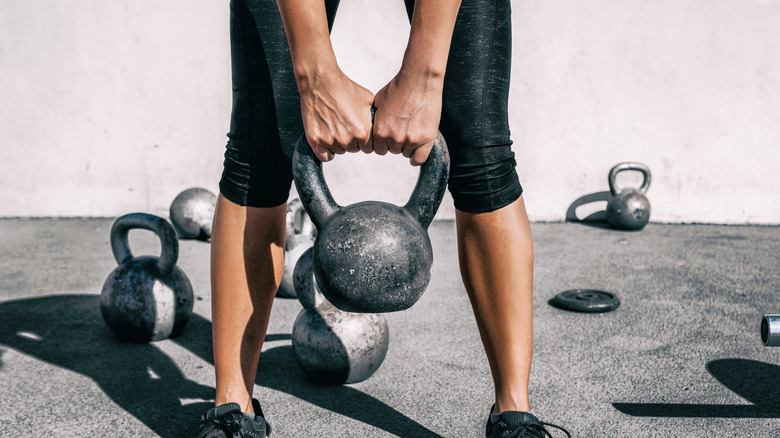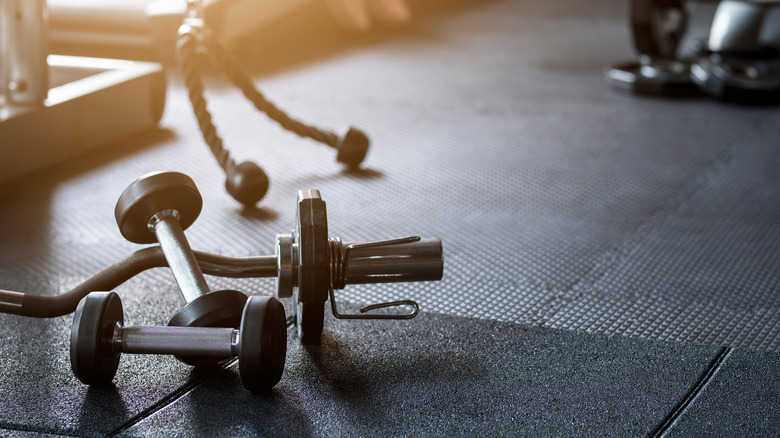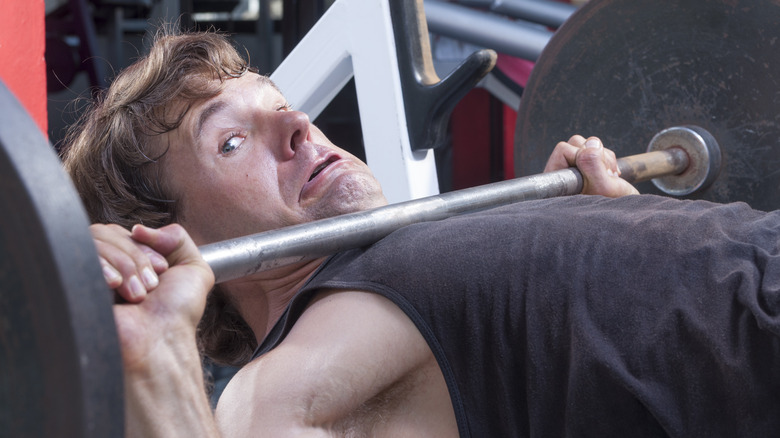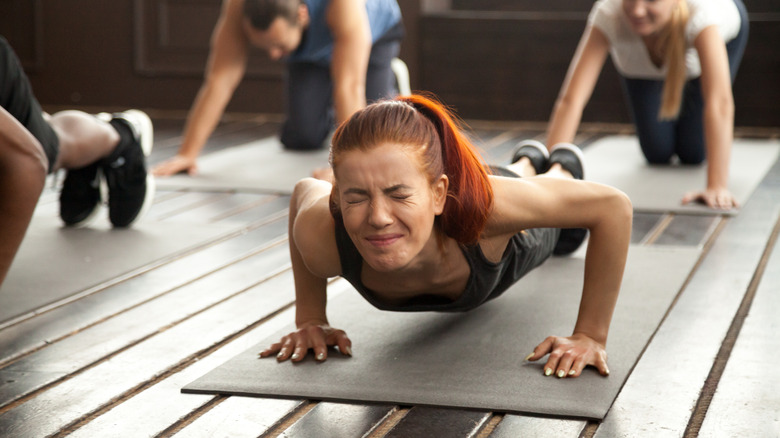Everything Beginners Should Know Before Strength Training
Strength training might be simultaneously the most rewarding and the most daunting aspect of exercise. But while it's tempting to view strength training as the preserve of fitness fanatics, more and more people are waking up to the positives of resistance workouts. The size of the strength equipment market value across the world has risen steadily since 2016, with a projected size of a whopping 1.17 billion dollars by 2025 (per Statista). Clearly, the days of lifting weights being just for the Arnold Schwarzeneggers out there are long gone.
And according to Canfitpro-certified celebrity personal trainer Ramona Braganza, this shift in perspective about strength training is only a positive thing. "For some people, the phrase strength training is intimidating, but it's enhancing your ability to move safely and effectively in your life," Braganza says via Everyday Health. With strength training also offering benefits to our heart health, bone strength, mood, and general body composition (per Healthline), there's never been a better time to pick up a pair of dumbbells. But if you've never embarked on strength training before, where do you begin? We wanted to lift the lid on that very topic here at Health Digest, so join us as we break down the essentials you need to know.
Hydration is key
Hydration is naturally important in every aspect of life, and particularly so during exercise. But we tend to associate proper hydration with more cardio-based exercise activities, where images of sweat pouring off people on running tracks or on bikes are pretty abundant. However, hydration is equally as important during resistance training, with inadequate water levels potentially leading to a large decrease in performance, as well as muscle cramps, headache, and fatigue (per Bodybuilding.com).
Just a relatively small shift in water levels can result in dehydration, and can make your workout much less effective. A study published in the European Journal of Applied Physiology found that people engaging in strength training with a 3% loss of body mass due to dehydration weren't able to do as many reps, perform to as high a standard, felt as though they were working much harder for the same result, and took longer for their heart rate to recover. Make sure you hydrate yourself well before any strength training session, and drink water throughout and after a workout as well. That said, try and steer clear of drinking too much liquid in one go, as it'll just fill your gut up and make you uncomfortable (via Bodybuilding.com).
Begin with your body weight
Are you finding that weights section in the gym a little intimidating? Never fear, as starting strength training by using your body weight is not only a totally viable thing to do, but also a smart and easy way to initiate your body to resistance exercise. Performing bodyweight strength exercises to build a fitness base allows you to work on the basics of proper form before you move up to equipment-based workouts, says Sweat. Bodyweight exercises also generally work with the natural movement of your joints and body, meaning that you're putting function and safety first.
It's important to remember that neither bodyweight exercises nor equipment-based exercises are "better," as Sweat stresses. It all depends on your individual fitness goals. Moreover, bodyweight exercises are still quite effective at building muscle, strength, and endurance. If you're just starting out, beginning with simple bodyweight exercises like squats, push-ups, and lunges are excellent ways to help introduce your body to the basics of resistance exercise. Once you've nailed your form and started to understand your body a little more when it comes to resistance training, it'll be time to progress to more advanced exercises or using weights. But remember, there's no rush!
You don't have to pay big bucks for a gym membership
There's always some person with a raised eyebrow at people who claim to work out without having a gym membership. "What can you really get done with a home workout?" they seem to be sneering. Well, as it turns out, a lot.
Working out at home is a perfectly viable approach to resistance training: You can learn the basics, see some serious results, and avoid having to pay a load of cash for an environment that you might not yet feel comfortable in, says Verywell Fit.
What's more, working out at home instead of at the gym offers you a ton of variety, according to Orlando Health. Sign up to an exercise app, join a class online, or hit YouTube and search for your favorite beginner strength training videos ... and trust us, there are a lot out there. Just remember that when you're working out at home instead of paying for a gym membership, it can be easy to feel less accountable to work out consistently — and building up to regular exercise is the key to seeing results from resistance training. Work out in a place with plenty of space, and make sure you're warming up and cooling down adequately.
With gym machines, heavier isn't always better
So you've signed up for the gym, and you're hitting the machines for the first time. First off, congrats! Taking the first tentative steps to gym machines is no small thing, and should be applauded.
Once you get yourself settled in them, though, don't assume that to build big, you have to lift big. "Most of the mistakes that are made on machines are because people trying to lift heavy rather than just lifting in the correct pattern," says PureGym's Peter Williams to Coach. Instead, don't be afraid to start small with the amount of weight you're using — primarily to get used to the motion of the machines, but also to figure out how much weight you need. Ideally, you'll be using enough weight to get through all of your sets and reps, while being on the edge of fatiguing your muscles once you finish.
Remember to keep your movements controlled, and don't rush through your workout. "If you let the weight stack crash up and down, you're not controlling the weight and not creating time under tension," says Williams.
Don't be scared — no one's expecting you to know how the equipment works
Look, we're just going to say it. No one is born knowing how gym equipment works. And if you've ever had the fear of embarrassing yourself on a weights machine, you're not alone. Remember, everyone has to start somewhere — and if you don't know how a piece of equipment works, that's okay!
The first thing to do is to read the instructions on the machine, as there's usually a panel on its side telling you how to work it. Take your time to do so or take a photo of the instructions and read them in a separate area, says Verywell Fit. Look for the adjustment points on machines, too. Everyone's built differently, and you need to make sure that you've adjusted the machine to your height, weight specifications, and postural requirements. Feel the machine out once you've adjusted it, as you should be able to tell instinctively whether you're hyperextending or if things are feeling a little uncomfortable. If in doubt, bring a buddy who's used the machines before, or seek out someone who works at the gym to guide you through things for the first time. Later down the line, you'll be thankful you did.
Don't skip the free weight section
The free weight section might seem simple, but it's probably the scariest part of the gym for a lot of people. After all, if you're not sure that you're using the weights correctly, it's better to stay on the machines, right?
Well, if you're a newbie to strength training, we encourage you to make friends with the weights section fast. "Using free weights allows you to work various muscle groups, depending on the exercise as well as strengthening stabilizer muscles," says V Shred's co-founder and lead trainer Vince Sant to Well+Good. Not only do free weight exercises offer a serious strength workout for the muscle you're targeting, but as Sant says, they help to "strengthen your body overall, even if you don't realize it, and improve coordination."
Using free weights also helps to keep your body moving more naturally throughout a workout. "You're going to have more of a free range of motion due to being able to move the weights in any direction you please," states Sant. And remember, free weights movements don't have to be complicated: Many of them, like shoulder presses and bicep curls, are arguably easier to perform with free weights than on machines.
Make sure the weights you're lifting aren't too heavy
In your haste to go from beginner to pro, you might be feeling tempted to go for the heaviest weight that you can handle on your very first session. But remember, picking the heaviest weights won't necessarily mean your gains will be bigger. You need to pick the right weight for your strength level.
When working with dumbbells, Second Chance Lifestyle and DailyBurn trainer Ben Booker recommends using both a light and a heavy set of weights during your workouts, as each set will help your body work on different things (per DailyBurn). Your lighter weights will help to "stabilize the muscle, which supports joints and tendons," while your heavier weights will help to build muscle mass.
But how do you figure out which weights to use in the first place? Again, Booker has the score. For men, he suggests using a pair of 10- to 20-pound dumbbells to start, and for women, he advises using 5- to 10-pound weights. Alternatively, you can perform the dumbbell test by doing biceps curls with a set of dumbbells until you become fatigued. Ideally, you should be able to perform 14 to 22 reps. If you can't get to 14, lower your weight by five pounds, and if you go above 22 easily, increase the weight by five pounds more.
Warming up is key
Okay, hotshot, we know you want to get in there and tear it up. But before you do, don't neglect your workout. A good workout is the key to strength training success. It makes sure your blood is moving around your body properly, giving your muscles increased blood flow and making your workout both more efficient and safer (per Bustle). Crucially, warming up properly prevents the risk of injury, which LifeTime personal trainer Brooke Van Paris describes by comparing our muscles to an old rubber band. "When you go to pull on it, it snaps. Same with our muscles. If they aren't warmed up properly before intense exercise or heavy loading, it causes a lot of stress on the body and can result in injury." We definitely don't want that, folks.
While it might seem enough to simply do a few jumping jacks, it's vital to make sure that your muscles are properly stretched and supple before hitting them hard. "Stretching is especially important because lifting weights puts so much stress and pressure on your muscles," advises StretchLab's director of education and certified strength and conditioning specialist Austin Martinez (via Bustle). A good warm-up pre-workout should consist of five minutes or so of aerobic exercise, followed by some stretching exercises — ideally dynamic stretching, which keeps your muscles moving before you hit the weights.
It's okay to start with a basic set of moves
If you're just hitting the strength training for the first time, it's tempting to forego those push-ups and head straight for the pistol squats. After all, you want these workouts to be effective, don't you? Sure, but it's useful to keep in mind that the basic moves work for a reason — and until you master things, there's no sense in making things too complicated.
This is why Body by Hannah owner and certified strength and conditioning specialist Hannah Davis advocates keeping things simple at the start. "Stick to the same basic moves two to three times a week to build a basic level of fitness and strength," Davis says to SELF. "Why complicate things if you don't have to? Great results can be made by repeating the same workout, but increasing weights as you become stronger." Once you increase your base level of strength, your body will become naturally more able to do more complicated moves or sequences. That said, if it ain't broke, don't fix it.
Don't underestimate the importance of form
Most people who start strength training assume that the amount of effort they put in equates to what they get out of it. But all of that effort won't amount to much if your form isn't on point first.
Making sure your form is correct when you begin strength training will not only lead to better habits later down the line, but will crucially ensure that your exercises are targeting your muscles effectively (via the National Federation of Professional Trainers). By involving other parts of the body that aren't being targeted or used during exercise, you can negate the impact your exercises are having on your intended muscles and inadvertently be targeting other areas instead.
More importantly, involving other parts of the body through improper form can also lead to injury. When your form is incorrect, you can end up placing your joints, tendons, and other muscles in positions that can cause them to become strained or torn.
Trying to do too much too soon won't go well
Strength training is a marathon, not a sprint. It's for that reason that it's advisable to remember to take things slowly at the beginning. One of the most common mistakes that beginners make when they start is to work out beyond their capacity, says Strong With Sivan owner and certified personal trainer Sivan Fagan, and this can lead to things being over before they've really begun (per SELF).
Instead, keep your number of workout days on the lower side at the beginning. "Start with two days for two to three weeks, then add a third day," advises certified strength and conditioning specialist Hannah Davis (via SELF). "Ideally, you should strength train three to five days per week, but work your way up—starting off at five days a week might shock your body."
Also, don't forget that strength training isn't the be-all-and-end-all of exercise. Incorporating cardio on your off days will help keep your body active and support your cardiovascular health. Aim for 150 minutes per week of moderate-intensity cardio activities such as brisk walking, or 75 minutes per week of more vigorous activities like running or jogging, recommends the CDC.
Your nutrition is as important as your time in the gym
To nail a strength training program, the time you spend in the gym is only half the battle. If you're not supporting your exercise and your body with proper nutrition, you'll find that your gains won't quite take off the way you want them to.
Fuelling your body with the right balance of carbohydrates, fats, and proteins is essential to the building and maintenance of muscle mass and stamina, states the American Council on Exercise. Without proper nutrition, you could end up seeing your muscles get smaller, as well as increase your risk of injury, lose bone density, and take longer to bounce back between workouts.
Before a strength workout, eat a few hours before hitting the gym. Prioritize carbohydrates to keep your blood sugar sustained throughout the exercise. Try and limit fats and fiber as much as possible, as these can cause bloating and gas. Additionally, make sure you're getting enough protein. After a workout, you'll want to eat fairly quickly — between 30 minutes to an hour after finishing. Your meal or snack should be composed of roughly 25% protein and 75% carbs; something simple like a banana with nut butter should do the trick.
Stretching after a workout will help you bounce back
So, you've crushed your workout. High five! Before you celebrate by kicking back on the sofa, though (which we highly recommend after a big workout, speaking from experience), make sure you take some time to stretch it out.
Stretching after a workout is an often-skipped but essential part of any exercise regime. Stretching after strength training helps maintain and improve flexibility, keep your posture in good order, and reduce muscle tension, per Healthline. Regular stretching also helps to improve circulation throughout your body, as shown in a study published in The Journal of Physiology. This helps your muscles to recover faster.
While a lot of people skip stretching because of the time they think it takes, it actually won't take you very long at all, particularly if you perform stretches that hit several muscle groups at the same time. A lunging hip flexor stretch will help stretch out your glutes, hips, and quads after a leg workout, and a standing biceps stretch will target your shoulders and chest as well as your arm muscles. Just make sure, as with your workouts, to not overdo your stretches. Take things slowly, remember to breathe through them, and make sure you stop and reduce the intensity of the stretch if you're feeling any pain.
If you do too much, you run the risk of overtraining
Starting a new workout routine is usually accompanied by a healthy dose of enthusiasm, which we're here for. But as with most things in life, pacing yourself is essential for any new strength training regime. By going too hard and too fast, you run the risk of overtraining — and as Verywell Fit states, the symptoms of this could be harder to spot than you think, particularly if you're new to exercise.
Although certain signs of overtraining like fatigue or excessive pain in your muscles or joints might be clear, others such as insomnia or loss of appetite may be harder to link to overtraining. Training too hard or with too much frequency may also produce headaches, a lack of motivation, and a weakened immune system.
The most important thing is to listen to your body: If you're working out too hard, it'll tell you. If you notice any signs of overtraining, you must pull back on your exercise, take additional rest days, or replace your regular workout with something lower-impact like walking or yoga. Continuing to train despite symptoms of overtraining can increase your likelihood of an injury, so don't risk it.















